Top News

April 8, 2022 Ryukyu Shimpo
By Teppei Ikeda
Okinawa governor Denny Tamaki held a press conference the evening of April 7, where he indicated that the prefecture is once again at a heightened sense of risk with daily new cases of COVID-19 in Okinawa had surpassed 1,000 per day, stating “We must recognize that we have already entered into a seventh wave.” He stated that if they are unable to halt the spread, they would need to enact semi-state of emergency COVID-19 measures and would need to look into restricting economic activity, and he asked the people of Okinawa to take thorough steps to halt the spread of the virus.
On April 7, the number of new positive cases increased by 233 week-over-week to 1,355 cases, and it was reported that 107 of the cases were people related to the U.S. military. In the press conference, Tamaki indicated that the BA.2 variant, which is considered more contagious than omicron, continued to take over as the main variant of new cases, and he indicated that these cases would continue to increase globally.
He asked Okinawan residents to 1. Avoid things that would put elderly people at risk of infection 2. Refrain from parties for company employees, or any events involving eating and drinking (or keep events to four people or less and under two hours) 3. Refrain from parties to welcome new college students, especially ones involving drinking. Tamaki also indicated that they asked each government department to explore policies that would help prevent the spread of the disease at a task force meeting earlier that day.
(English translation by T&CT and Sam Grieb)
Go to Japanese
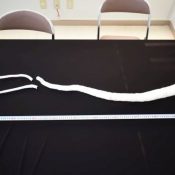
April 8, 2022 Ryukyu Shimpo
By Shugo Asato
The first entotsugai (giant shipworm) to be observed in Japan has been confirmed in Funauki Bay of Iriomote Island in Taketomi, Okinawa. The entotsugai is the longest bivalve in the world and forms a calcareous tube that is distinct from its shell. The tube can be longer than 1.5 meters. The shell and the soft body of the entotsugai are inside of the tube.
The entotsugai was discovered by Doctor Hiroyuki Ozawa of the Okinawa Prefecture Environment Science Center and his team, who were out doing work for the prefecture. Ozawa says, “This discovery is another confirmation of the abundance of the ecosystems around Iriomote Island and Okinawa.”
Entotsugai have been confirmed living in the tropical regions of the Indian and the western Pacific Oceans. The furthest north they had been observed was in the Philippines. However, the discovery in Japan means that the northern limit of their habitat will be redrawn. Additionally, entotsugai are known to live in the waters near mangrove forests, but have now also been observed living in the sandy ocean floor around marine kelp forests.
Ozawa says, “This is an incredibly rare animal that, even within the Iriomote Island area, has only been observed in a very limited part of Funauki Bay. It is my hope that Japan, Okinawa, and Taketomi will quickly take action to protect and conserve the species.”
(English translation by T&CT and Ellen Huntley)
Go to Japanese
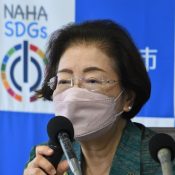
April 7, 2022 Ryukyu Shimpo
By Sanenori Kinjo
During a regular press conference held on April 6, Naha City Mayor Mikiko Shiroma spoke on the incident in which a U.S. soldier pointed a gun at a Ryukyu Shimpo reporter positioned outside the base’s fence line at the Naha Port Facility during a drill. The mayor stated, “It is an infuriating act that should never have happened.”
The U.S. Army on Okinawa denies the soldier intentionally pointed his gun at the reporter. Mayor Shiroma responded, “If you look at the [Ryukyu Shimpo] photo, [the solider] is clearly making eye contact with the reporter. The journalist was holding a camera; it must’ve been obvious he was reporting.” She asserted, “you cannot argue that pointing a gun at unarmed civilians positioned outside the base’s fence lines is part of the drill.” The mayor said of the military exercises at the port: “I have repeatedly conveyed to the Defense Bureau that these exercises are not in line with the 5-15 Memorandum (which stipulates the primary use of Naha Military Port) but without progress. We will continue to demand that the training be strictly controlled.”
(English translation by T&CT and Monica Shingaki)
Go to Japanese

April 1, 2022 Ryukyu Shimpo
On the evening of March 31, the U.S. Army stationed in Okinawa conducted guard and protect training at the U.S. military’s Naha Port Facility (Naha Military Port). Armed soldiers carrying guns and guarding a warehouse at the port were observed from along National Route 332. One soldier pointed the muzzle of his gun at a cameraman for the Ryukyu Shimpo, who was taking photographs from outside the military base fence.
“The soldier held his gun at the ready for several seconds”, reporter explains the event that occurred while he was taking photographs
The U.S. military issued prior notice about the training to the Okinawa Prefectural Government (OPG) via the Okinawa Defense Bureau, however, no information about soldiers being armed was conveyed.
The OPG sent some personnel to the site to observe the training. According to the OPG, the training was primarily conducted by the U.S. Army’s 835th Transportation Battalion. A spokesperson for the U.S. military explained that this is routine training.
According to observations by the Ryukyu Shimpo, U.S. military police vehicles and transport vehicles were gathered in front of the warehouse at the port, and, whe
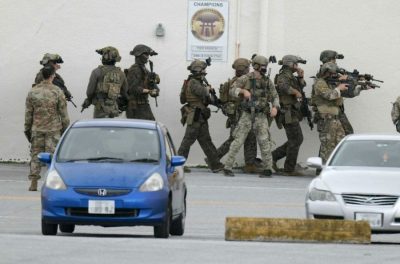
Around 5:20 p.m. on March 31 at the Naha Port Facility, armed soldiers engaged in training activities on the facility grounds while holding their rifles at the ready
n approximately 20 soldiers holding their rifles at the ready entered the warehouse, it could be seen that vehicles followed. According to the OPG, a small military transport vessel also approached to moor at the port.
Training involving the flight of MV-22 Osprey from Futenma Air Station was also conducted at the Naha Port Facility in February. At that time, armed soldiers were observed guarding a building from a group who appeared to be acting like demonstrators. (compiled By Manato Akira)
(English translation by T&CT and Erin Jones)
Go to Japanese
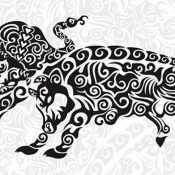
April 3, 2022 Ryukyu Shimpo
By Yosuke Anri
Tokyo – Minister of State for Okinawa and Northern Territories Affairs Kosaburo Nishime announced the results of the 2021 Kariyushi wear design contest at a press conference following a cabinet meeting on March 29. From 398 submissions, the winner was Yuuma Minatogawan, 27, from Chatan) for his fighting bull pattern titled “Ryukyu Tribal Fighting Bull.” The winner of the photo contest was Maruku Tachibana (27, Tokyo), whose photo “Tiny Me” won out over 838 total entries.
The works were collected on the “Okinawa41” website run by the cabinet office.
Minatogawa’s illustration shows two bulls locking horns in a pattern inspired by Pacific Islander tribal patterns. He commented, “I combined something traditional with something fresh,” and was happy to win the award.
Tachibana captured a beautiful picture on film of the Cape Shiratori coastline in Irabu, Miyakojima at night.
“Each star is glittering on their own, but together, which gives birth to hope and possibility,” she said of her picture.
(English translation by T&CT and Sam Grieb)
Go to Japanese

March 26, 2022 Ryukyu Shimpo
By Chie Tome
As concerns the fishing agreement between Japan and Taiwan pertaining to fishing rights in the surroundings of the Senkaku Islands, the present operational rules which have been in place since 2019 are set to stay in place throughout 2022, as well. The Japan-Taiwan fishing commission, which addresses these operational rules, has not been able to hold a meeting due to the coronavirus epidemic, and has not had the chance to revise the agreement. The commission meeting has been put off for three consecutive years.
The Japan-Taiwan Exchange Association made an announcement about the information above on March 25.
About 60 percent of a triangular ocean area to the north of Yaeyama, which serves as a zone where long line fishing for tuna is permitted, is currently sectioned off and prioritized for preferential use by Taiwanese fishing boats. Therefore, Japanese fishermen are requesting that the triangular ocean area be divided equally.
Chairman Kameichi Uehara of the Okinawa Prefecture Fisheries Cooperative Association showed the definitive understanding that, with consideration to world affairs, the current operational rules will inevitably be discontinued. However, Uehara made clear that he cannot accept this continuation of the operational rules from the 2019 fishing season, and said: “I want to ask that a safe and peaceful ocean area be maintained under Japan’s operational rules, as requested by this prefecture’s fishermen.”
(English translation by T&CT and Erin Jones)
Go to Japanese
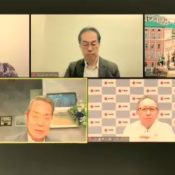
March 27, 2022 Ryukyu Shimpo
By Shohei Tsukazaki
Okinawa Prefecture hosted a symposium titled “Think with Governor Denny – working towards peace with Asia and Okinawa,” March 26, held online over video conference. Okinawa governor Denny Tamaki plans to start the “U.S. Military base issue advisory board” comprising national security experts in May, and will listen to their opinions on the international political climate, which he will use to help inform policy in Okinawa.
At a press briefing after the seminar, Governor Tamaki explained the goal for the expert advisory board, saying, “I want to ask for an analysis of the current international situation, and what actions we can undertake from Okinawa.” When asked if topics such as the Russian invasion of Ukraine and the situation in Taiwan would be addressed, he responded, “We will gather that information from the members ahead of time.”
The advisory board was established as the successor to the “Bankoku Shinryo Conference on U.S. Military Base Issues,” which was outlined in the 2019 policy recommendations, and had its first meeting in August of last year.
In addition to governor Tamaki, the online symposium was attended by former Assistant Deputy Chief Cabinet Secretary Kyoji Yanagisawa, Aoyama Gakuin University emeritus professor Kumiko Haba, and former Ministry of Economy, Trade, and Industry (METI) policy advisor Shigeaki Koga, where they discussed the possibility of Okinawa directly working to relieve tensions in Asia.
Professor Haba suggested that Okinawa could be used as the hub of a trust-building network in Asia. She explained that the history of European Integration after World War 2, saying, “It is necessary to build an Non-Governmental Organization (NGO) to address issues such as the environment, security, and peace, with Okinawa and Taiwan as the axes.”
(English translation by T&CT and Sam Grieb)
Go to Japanese
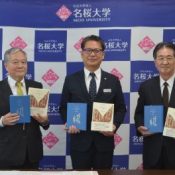
April 1, 2022 Ryukyu Shimpo
By Kotaro Nagamine
Nago – On March 30, “Omoro Soshi, Part 1”, the first volume in the 35-volume Compendium of Ryukyu Literature (Ryukyu Bungaku Taikei), was released by Meio University in Nago. Work to edit and publish the compendium began in 2019. The compendium is intended not only for experts, but also for the general public, and so includes plentiful footnotes and commentary. Volume 1 is expected to be available for purchase in bookstores throughout Okinawa starting in early April.
On March 31, Meio University President Masanori Sunagawa, Editing and Publishing Committee Chair Eikichi Hateruma, and Honorary Chair Katsunori Yamazato held a press conference at Meio University to introduce the work.
The Omoro Soshi is a collection of songs and poems (omoro) that were performed in the Ryukyu Kingdom for religious events or other occasions. The book about to be released includes 651 songs from volumes 1-11 of the Omoro Soshi. “Omoro Soshi, Part 1” includes notes above the original text to explain the language used, a translation below, and a synopsis or commentary next to the text. Hateruma says, “The text is very easy to understand, even for the general public.”
Sunagawa says, “We expect that Uchinanchu around the world who treasure their Okinawan identity will take comfort in the work being done to preserve and research Okinawan history, culture, and language.”
The plan is to complete the Compendium of Ryukyu Literature by 2030. Yumani Shoubo in Tokyo will be in charge of publishing and sales. Volume 14, “Kumi Odori, Part 1” will be released in September 2022, volume 11, “Ryuka, Part 1” will be released in December 2022, and volume 2, “Omoro Soshi, Part 2” will be released in March 2023.
(English translation by T&CT and Ellen Huntley)
Go to Japanese

March 30, 2022 Ryukyu Shimpo
By Yo Kakazu and Yosuke Anri
On March 29, the Ministry of Education, Culture, Sports, Science and Technology (MEXT) announced its approved list of high school textbooks for the 2023 academic year. The publisher Shimizu Shoin’s textbook for the newly established elective course Advanced Japanese History (which will replace Japanese History-B) banishes the October 10, 1944, air raid on Okinawa, also known as the 10/10 Air Raid, stating that “The first indiscriminate attack [during the Pacific War] was the bombing of Tokyo, carried out during the early morning of March 10, 1945.” None of the seven approved textbooks created by the five publishers mention the 10/10 Air Raid. Furthermore, none of the textbooks clearly mention the Japanese military orders of the mass suicides (compulsory mass-suicide) committed in the Battle of Okinawa.
MEXT did not issue any official comments on Shimizu Shoin’s textbook description of the air raids but maintained that the description is “not false,” citing numerous other history books.
In reality, during the 10/10 Air Raid, the U.S. military dropped bombs and incendiary devices on Okinawa’s main island and surrounding islands over the course of its fifth offensive. U.S. official records indicate that the Japanese government at the time protested to the U.S. that the attack was an “indiscriminate” one.
Shimizu Shoin declined to answer this paper’s questions about the erroneous information presented in its textbook.
Two of publisher Jikkyo Shuppan’s textbooks offers maps in which Okinawa is labeled with the text: “10/10/1944 Naha Air Raid.” Jikkyo Shuppan explained that the term “10/10 Air Raid” is narrowly used and does not appear in the textbook itself, therefore inappropriate for high school students to cram. Two previous textbooks approved in March 2021 for the required course Modern and Contemporary History include descriptions such as: “Naha was bombed and destroyed,” but no further details are provided.
Furthermore, Jikkyo Shuppan’s Advanced Japanese History textbook incorrectly states that the Mariana Islands were captured in 1945 (it fell in 1944). Meanwhile, Daiichi Gakushu-sha publishing describe the Himeyuri students as “student nurse corps” in its textbooks. Concerned parties have requested this description be corrected, noting it could be misread as if the students had joined the corps and participated in the war of their own volition.
(English translation by T&CT and Monica Shingaki)
Go to Japanese
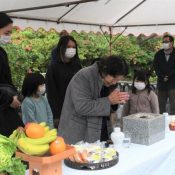
March 29, 2022 Ryukyu Shimpo
By Sanemichi Kinjo
Tokashiki – March 28 marks the 77-year anniversary of the compulsory mass-suicide in Tokashiki, which took place during the Battle of Okinawa, and 40 people comprising residents of the village and descendants of the victims visited Shiratama no Tou to pray for the souls of the victims and stand against war. Due to COVID-19, the memorial service hosted by the village has been cancelled three years in a row, but the town provided incense and offerings, allowing people to come and pray on their own.
On March 27, 1945, the U.S. military landed on Tokashiki Island. At the order of the Japanese Imperial Army, the village residents gathered in a cave in Nishiyama on the northern side of the island, however their refuge was destroyed, and on March 28, 330 people became victims to things such as hand grenades.
Kiyoko Oshiro, 88, originally from Aharen, Tokashiki – now in Itoman, traced her fingers over the names of her grandmother, mother, and siblings, with tears in her eyes. Oshiro was taken to the Nishiyama cave with her family, and was surrounded by the mass-death event in the cave. “I thought I was going to be killed, and afraid I lay next to a corpse and pretended to be dead, which allowed me to survive. However, my mother and sister died. Whenever I come here, I always remember that time.” She comes every year on March 28 to pray. This year, she was accompanied by her grandchildren and great-grandchildren. “I will visit as long as I am alive,” she says, pinching at the bridge of her nose and staring at the memorial.
Mitsue Arakaki, 73, a peace studies instructor in Tokashiki, came with her granddaughter Kei Uechi, 9, carrying flowers, and asked for “a world at peace” with her eyes closed. “For people our age, the scars of war on the island were still vividly present when we were growing up, and there were many stories from the older children on the island. I want to tell those who passed on that we are working to prevent such a tragic war from happening again.”
(English translation by T&CT and Sam Grieb)
Go to Japanese
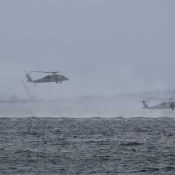
March 25, 2022 Ryukyu Shimpo
By Shohei Tsukazaki and Hideki Matsudo
On March 22, two helicopters, which were recognized as U.S. military aircraft, were used for suspension training and the like in Nago Bay, Nago City, and on March 24, the U.S. Navy was recognized as the branch conducting the training. In an interview with the Ryukyu Shimpo, a spokeperson for the U.S. Navy answered that U.S. Navy MH-60S helicopters belonging to the Helicopter Sea Combat Squadron 12 were the ones used for the training. No answer was given as to the reason that training was conducted outside of areas for U.S. military use without notice.
On March 23, a spokeperson for the Okinawa Defense Bureau (ODB) told a reporter for the Ryukyu Shimpo that the ODB is in the process of inquiring with the U.S. Navy about the facts surrounding the training, and that, presuming the helicopters were indeed U.S. military aircraft, the U.S. military has continually been asked for proper consideration to public safety in Japan, for adherence to the Japan-U.S. Joint Committee Agreement, and for the effects of U.S. military activity in the area to be minimized.
The Japan-U.S. Joint Committee agreed that the International Civil Aviation Organization (ICAO), the minimum safe altitude stipulated in Japan’s aviation law, and flight behavior regulations in Japan’s aviation law all apply to the flight of U.S. military aircraft. Aviation law establishes the minimum altitude in vacant areas as 150 meters above sea level, and the like. The aircraft used to conduct training a Nago Bay came close enough to almost touch the surface of the water, and hovered approximately 10 meters from the surface of the water.
A spokeperson for the U.S. Navy said that they are making efforts to secure a free and open Indo-Pacific region while fulfilling the duties outlined in their agreements with Japan, and that it is necessary to conduct essential training in order to maintain high responsiveness.
(English translation by T&CT and Erin Jones)
Go to Japanese












 Webcam(Kokusai Street)
Webcam(Kokusai Street)


